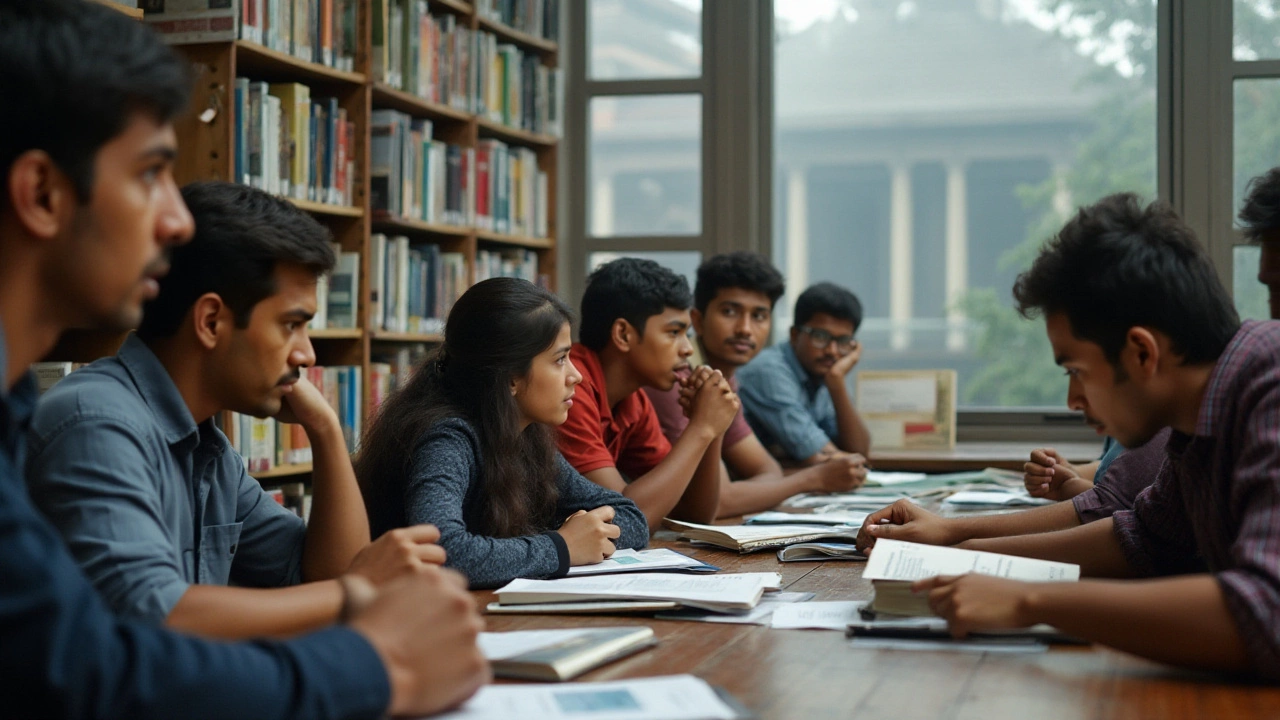Deciding which branch of the Indian Institutes of Technology (IIT) to pursue is a pivotal moment for students aspiring to excel in engineering. Each branch offers its unique set of challenges and rewards, but some are notoriously demanding, testing even the most dedicated students.
As you immerse yourself in the world of IITs, understanding the intricacies of different branches can guide your preparations and expectations. Be it Computer Science, Electrical Engineering, or Mechanical Engineering, each has its own hurdles.
This article aims to shed light on which branches are often regarded as the toughest, diving into the core elements that contribute to their rigorous nature. Whether you're a future engineer seeking the thrill of a challenge or simply wanting to make informed decisions, understanding these aspects is crucial.
- Understanding IIT Branches
- Factors Making a Branch Tough
- Top Challenging Branches
- Tips for Surviving a Tough Branch
Understanding IIT Branches
When embarking on the journey of choosing a branch at the Indian Institutes of Technology, you are stepping into a world teeming with diverse possibilities. Among these choices, each branch possesses its peculiar focus, curriculum demands, and inherent challenges, which aspiring students must consider. A world-renowned institution, IIT molds some of the finest engineering minds, and the branches you choose can significantly shape your future career path. While decisions often revolve around personal interest and career prospects, understanding each branch's unique aspects can guide a student more profoundly in making an informed choice.
It's important to note that despite the universal recognition of certain branches as inherently demanding, the level of difficulty can be subjective, depending on the individual's aptitude and interest. For instance, IIT JEE serves as a gateway to several disciplines such as Computer Science Engineering, Electrical Engineering, Mechanical Engineering, and Civil Engineering. Each of these carries its specific set of expertise and career paths. Computer Science, with its explosive growth in the technology sector, attracts a significant number of aspirants annually. Alongside it stands Electrical Engineering, known for its challenging mathematical and circuit design concepts. Mechanical Engineering boasts a comprehensive understanding of mechanics, energy, and materials—an ever-relevant field across various industries.
"The journey of an engineer begins with the curiosity to unravel technology's mysteries, and in IIT, this curiosity finds the perfect breeding ground," shares Dr. Ashwin Desai, a respected professor at IIT Bombay.
Let us not forget branches like Chemical Engineering, Aerospace Engineering, and the more recently popular Data Science, each offering a unique twist in the expansive field of engineering. IITs are equipped with cutting-edge labs, industry collaborations, and an enriching academic ecosystem to provide you with the skills and knowledge to tackle real-world problems. As the first step, researching what each branch entails could broaden your horizons and align your choices with your strengths and aspirations.
Analyzing the trends in students' preferences, certain statistics often reveal an interesting insight into branch competitiveness. Year after year, Computer Science Engineering appears to have the highest cutoffs in entrance exams, closely followed by Electrical and Mechanical engineering. This gives us a glimpse into the performance pressures and the high standards expected of these courses. As a decisive qualifier for engineering aspirants, the entrance exam results often reflect the uphill task many students face in their pursuit of excellence at IITs. Understanding these aspects, while introspecting your own interests and proficiencies, can ultimately guide you in selecting the right branch and excelling in your IIT preparation.

Factors Making a Branch Tough
When we dive into the realm of IITs, it's essential to understand the nuances that make certain branches tougher than others. One of the primary reasons is the curriculum intensity. Branches like Computer Science or Electrical Engineering often have densely packed syllabi filled with complex theories and extensive practical applications. The pace at which students need to learn new concepts and technologies can be overwhelming. Not only do these branches require a solid grasp of mathematical foundations, but they also demand an ability to think analytically and solve problems rapidly.
Another element contributing to the toughness of a branch is the competition within it. Popular branches attract the brightest minds, creating a highly competitive environment. Students are often required to maintain a high level of performance consistently, which can be mentally exhausting. The need to constantly stand out among peers and excel in projects, presentations, and exams can add a significant layer of stress.
The size of the knowledge base in certain branches cannot be overlooked either. For example, the field of Mechanical Engineering encompasses a wide range of topics like thermodynamics, fluid mechanics, and materials science. Each topic is a discipline in its own right and understanding them at a deep level takes time. The breadth of subjects requires students to master diverse topics, similar to the preparation needed for an interdisciplinary marathon.
"The future belongs to those who believe in the beauty of their dreams." - Eleanor RooseveltDespite the tough nature of these branches, the challenge they present can serve as a motivation rather than an obstacle. Engaging with complex problems and finding innovative solutions prepares students for real-world scenarios. This unique educational experience fosters resilience and adaptability, skills that are invaluable beyond the confines of academia.
Moreover, the faculty expertise plays a vital role in shaping the difficulty of a branch. Institutes like IIT employ professors who are leaders in their respective fields. While learning from the best can be incredibly rewarding, it also sets a high bar for students who must match the expectations of these seasoned academics. Regular assessments, demanding assignments, and challenging exams ensure that students stay sharp and thoroughly engaged with the material.
Lastly, we must acknowledge the evolving technological landscape. Constant advancements in technology mean that engineering courses, particularly those in Computer Science and Electronics, must regularly update their curricula. What was cutting-edge last year might be obsolete today. Consequently, students need to stay abreast of the latest developments and trends, which demands ongoing self-learning and a proactive approach to education.

Top Challenging Branches
When it comes to the Indian Institutes of Technology (IIT), some branches stand out for their sheer rigor and academic demands. Among these, Computer Science Engineering (CSE) and Electrical Engineering (EE) are frequently cited as the pinnacle of challenging disciplines. Let's delve into why these branches are considered challenging and what makes them coveted choices among the brightest minds.
The allure of Computer Science Engineering lies in its revolutionary impact on the digital world. This branch demands a robust understanding of algorithms, data structures, and emerging technologies like machine learning and artificial intelligence. The curriculum is dense, requiring students to not only solve complex problems but also engage in extensive coding and projects. The pace at which technology evolves adds an additional layer of complexity, thrusting students into a continuous cycle of learning and adaptation. Professor Anil Pathak from IIT Bombay once remarked, "The immersive and dynamic nature of CSE prepares students not just for current technological challenges but for those yet to come."
A close competitor in toughness is Electrical Engineering, a branch renowned for its foundational and influential role in various technological fields. The intricacy of topics like circuit analysis, electromagnetism, and microelectronics means that students are often faced with intense theoretical concepts and exacting practical applications. This branch has a reputation for pushing students beyond their limits to innovate and apply their knowledge across industries. For those captivated by the idea of powering the world, Electrical Engineering at an IIT may just be the ultimate destination.
Why Students Choose Challenging Branches
Despite their challenges, these branches remain popular among IIT aspirants. The high demand for engineers in tech and electronics fields translates to attractive career opportunities and lucrative salaries. Moreover, students often find themselves in intellectually stimulating environments where collaboration with peers goes beyond the classroom. These branches attract a skewed ratio of applicants relative to availability, driving the IIT JEE cut-off scores even higher. Pursuing such demanding branches in the IIT realm is not just about academics; it's about proving one's mettle in an international arena. Here's a quick look at some competitive aspects through a snapshot of IIT graduation surveys:
| Branch | Percentage of Students Employed Post-Graduation | Average Starting Salary (USD) |
|---|---|---|
| Computer Science Engineering | 98% | 75,000 |
| Electrical Engineering | 95% | 70,000 |
Though these numbers can be daunting, they reflect the reality of rewards that accompany persistence through challenging IIT programs. Mastering a tough curriculum requires more than just intelligence; it calls for resilience, passion, and an unyielding drive to innovate. Students who take up the challenge of these branches often emerge with not just a degree, but the kind of experience that can shape a formidable career ahead.

Tips for Surviving a Tough Branch
Navigating through the challenging realms of IIT branches, such as Computer Science or Mechanical Engineering, demands more than just academic smarts. It calls for a strategic approach to learning and a mindset geared towards resilience. Many students enter IIT with a thirst for knowledge but quickly realize that surviving isn't just about keeping up with classes. It's about creating a sustainable study routine that balances academics with mental and physical well-being. Prioritize making realistic and achievable study goals instead of overwhelming yourself with the pressure to excel in every area.
Engaging in group studies can also bolster your understanding. Discussing concepts with peers often unravels more insights than solitary study sessions. However, it's crucial to form a study group with like-minded individuals who are committed to learning; this ensures sessions remain productive. Remember, time management is key, so allocate specific time slots for self-study, group discussions, and rest periods. And importantly, don't forget the power of networking. Building connections with seniors can expose you to practical insights, and they often have tried-and-tested notes, which can serve as invaluable resources during exams.
Stay Updated and Seek Help
Today's dynamic world of technology and research necessitates staying abreast of the latest developments within your field of study. Subscribe to relevant journals or online forums to enhance your knowledge beyond textbooks. Besides, tapping into the expertise of professors can also provide nuanced perspectives. Professors often have office hours where they are more accessible; use this time to address any academic struggle you face. If a particular concept seems elusive, don't hesitate to seek clarification immediately.As Dr. K. Narayan, a renowned professor at IIT Bombay, once remarked, "Surviving a tough branch is not about knowing everything but knowing where and how to find what you need."
Reflecting on his advice can transform your approach to learning. Instead of trying to memorize every piece of information, focus on mastering the art of effective search and understanding how to apply concepts practically.
Prioritize Health and Well-being
Equally important to surviving a tough branch at IIT is ensuring that you take care of your physical health and mental well-being. This often begins with maintaining a balanced lifestyle. Regular physical activities like jogging, yoga, or even leisurely walks can revitalize your mind, improving your ability to process information. Additionally, fostering good dietary habits and sleeping patterns plays an essential role in sustaining energy levels and concentration. Amidst the rigorous academic demands, remember that breaks aren’t a luxury but a necessity. They give your mind the required downtime to regenerate and absorb knowledge effectively.By implementing these strategies, you can create an environment where thriving—not just surviving—is possible, even within the most demanding IIT engineering branches. Balancing disciplined study habits with a healthy lifestyle might be challenging initially, but persistence, proactivity, and a keen sense of curiosity will guide you through the hurdles of tough branches.



